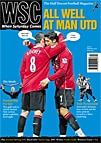 New owners and a new ground loom for Liverpool. Robert Fordham reports
New owners and a new ground loom for Liverpool. Robert Fordham reports
“In a strange way, it was also oddly reassuring. The whole soap opera signalled that, even as European Champions, Liverpool Football Club could still act like an unsophisticated local diners’ club or a parochial village-hall committee. We were still more of a flawed community than a slick corporation.” This (along with the player staying) is the bright side author John Williams finds in the surreal saga that saw Steven Gerrard come so close to leaving Anfield six weeks after lifting the European Cup. But the club Williams has followed all his life are on the brink of the biggest overnight change in their history. Slick corporation here we come.
Dubai International Capital have not concluded their deal just yet. But it seems a question of when not if they take over. At the heart of the reasons for David Moores seeking out and finally accepting a suitor is the broadly recognised need to finance an increase in capacity. And a bigger ground means a new one.
To compete better on the pitch, Liverpool must compete better off it. How can they, given the capacities of Old Trafford, the Emirates Stadium and Roman Abramovich’s pockets? How can they, though, leave home? The delay in the long-mooted plans helps to make the dilemma less complicated. A decision and announcement, say, five years ago would have been far-sighted, but the opposition to the principle would have been greater. Now, despite the success Rafa Benítez has enjoyed, the evidence of the problem is impossible to ignore.
As prospective new owners, DIC appeared at first to be a reasonably happy halfway house. Liverpool were not acquiring a bottomless pit of cash, despite the presence of Sheikh Maktoum in the background: this was an investment by a profit-making business. Nor were they being treated like some City company ripe for a leveraged takeover, with Glazer-style debts. These were both good things: few want their club to be the new Chelsea or Man Utd.
Then the Telegraph uncovered a document that suggested that DIC were not looking to be long-term owners and were seeking banks as investors, not so much to fund the purchase but for the building of the new ground. They were offering 20 per cent returns a year, without accounting for their own profits. Arsenal have raised money from institutions to fund a new ground that will more than pay for itself. The crucial differences are that the interest rates are far lower than the profits DIC are promising and that the Hill‑Woods and co remain in charge.
The document contained no mention of buying players. But this was not a full business plan and to fill the Stanley Park ground’s 61,000 seats a successful team is required. Much of the profits will come from the new TV deals. Corporate income should soar away from the tight confines of Anfield. But rather than the new stadium being a cash cow to build the team, it looks like it’s being built to turn the club into a cash cow. What will this mean for those struggling to pay current ticket prices? The new seats – let’s be honest – are targeted at the wider support, but many of them are buying into a sense of community that could be under threat.
Anyone from DIC looking to understand the club’s core support could do worse than read Williams’s latest book, Groove Armada, and both that volume and Guillem Balagué’s A Season on the Brink offer a significant insight into the manager. Benítez left Valencia because he was unhappy at how the club were run, at board interference in his day-to-day job. He will refuse to be taken for granted.
Balagué has updated his book about the previous campaign, with 30-odd pages of new material, mainly about Benítez’s second remarkable cup final triumph. Williams has started from scratch, in partnership with another Spanish journalist, Ramón Llopis. Neither approach is perfect.
A Season on the Brink may have been better left as it was, as a record of one unrepeatable year. With the updates it’s trying to pretend to be something it isn’t, a claim denied by the title. On the other hand, with amendments and corrections (Alex Miller is now restored to Scotland), the paperback is an improvement and a fine book – Balagué’s Spanish connections are well used – will reach a wider audience.
Williams and Llopis offer far more than a survey of last season. Strong chapters chart the historical parallels and divergences between Liverpool and Valencia as clubs and cities, and English and Spanish football. But recent events mean that it has dated quickly and there are a few too many mistakes: Brian Clough was not at Derby in 1975 and Atlético Madrid’s European Cup final in 1974 is first mentioned then overlooked, when Real’s 1981 side are called Spain’s first finalists in 15 years. I hope the end-of-an-era tome Williams is certain to write is as good on the detail as on the big picture.
The big question, as new owners and a new ground loom, is whether Liverpool books in five years’ time are simply mourning what has been lost rather than acknowledging a painful but successful trade-off.
From WSC 24o February 2007. What was happening this month